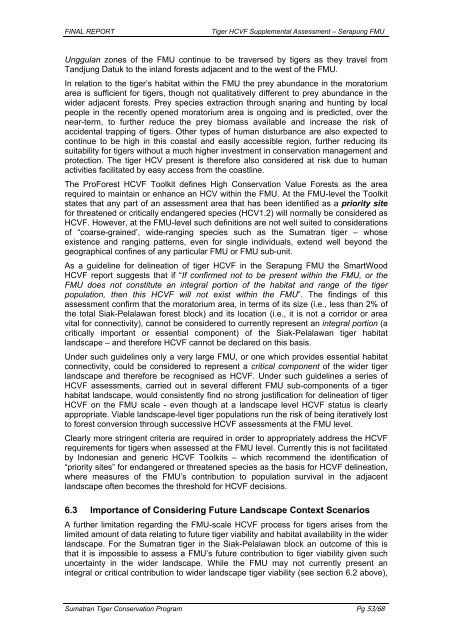A Supplemental HCVF Assessment on the Sumatran Tiger ...
A Supplemental HCVF Assessment on the Sumatran Tiger ...
A Supplemental HCVF Assessment on the Sumatran Tiger ...
You also want an ePaper? Increase the reach of your titles
YUMPU automatically turns print PDFs into web optimized ePapers that Google loves.
FINAL REPORT <strong>Tiger</strong> <str<strong>on</strong>g>HCVF</str<strong>on</strong>g> <str<strong>on</strong>g>Supplemental</str<strong>on</strong>g> <str<strong>on</strong>g>Assessment</str<strong>on</strong>g> – Serapung FMU<br />
Unggulan z<strong>on</strong>es of <strong>the</strong> FMU c<strong>on</strong>tinue to be traversed by tigers as <strong>the</strong>y travel from<br />
Tandjung Datuk to <strong>the</strong> inland forests adjacent and to <strong>the</strong> west of <strong>the</strong> FMU.<br />
In relati<strong>on</strong> to <strong>the</strong> tiger’s habitat within <strong>the</strong> FMU <strong>the</strong> prey abundance in <strong>the</strong> moratorium<br />
area is sufficient for tigers, though not qualitatively different to prey abundance in <strong>the</strong><br />
wider adjacent forests. Prey species extracti<strong>on</strong> through snaring and hunting by local<br />
people in <strong>the</strong> recently opened moratorium area is <strong>on</strong>going and is predicted, over <strong>the</strong><br />
near-term, to fur<strong>the</strong>r reduce <strong>the</strong> prey biomass available and increase <strong>the</strong> risk of<br />
accidental trapping of tigers. O<strong>the</strong>r types of human disturbance are also expected to<br />
c<strong>on</strong>tinue to be high in this coastal and easily accessible regi<strong>on</strong>, fur<strong>the</strong>r reducing its<br />
suitability for tigers without a much higher investment in c<strong>on</strong>servati<strong>on</strong> management and<br />
protecti<strong>on</strong>. The tiger HCV present is <strong>the</strong>refore also c<strong>on</strong>sidered at risk due to human<br />
activities facilitated by easy access from <strong>the</strong> coastline.<br />
The ProForest <str<strong>on</strong>g>HCVF</str<strong>on</strong>g> Toolkit defines High C<strong>on</strong>servati<strong>on</strong> Value Forests as <strong>the</strong> area<br />
required to maintain or enhance an HCV within <strong>the</strong> FMU. At <strong>the</strong> FMU-level <strong>the</strong> Toolkit<br />
states that any part of an assessment area that has been identified as a priority site<br />
for threatened or critically endangered species (HCV1.2) will normally be c<strong>on</strong>sidered as<br />
<str<strong>on</strong>g>HCVF</str<strong>on</strong>g>. However, at <strong>the</strong> FMU-level such definiti<strong>on</strong>s are not well suited to c<strong>on</strong>siderati<strong>on</strong>s<br />
of “coarse-grained’, wide-ranging species such as <strong>the</strong> <strong>Sumatran</strong> tiger – whose<br />
existence and ranging patterns, even for single individuals, extend well bey<strong>on</strong>d <strong>the</strong><br />
geographical c<strong>on</strong>fines of any particular FMU or FMU sub-unit.<br />
As a guideline for delineati<strong>on</strong> of tiger <str<strong>on</strong>g>HCVF</str<strong>on</strong>g> in <strong>the</strong> Serapung FMU <strong>the</strong> SmartWood<br />
<str<strong>on</strong>g>HCVF</str<strong>on</strong>g> report suggests that if “If c<strong>on</strong>firmed not to be present within <strong>the</strong> FMU, or <strong>the</strong><br />
FMU does not c<strong>on</strong>stitute an integral porti<strong>on</strong> of <strong>the</strong> habitat and range of <strong>the</strong> tiger<br />
populati<strong>on</strong>, <strong>the</strong>n this <str<strong>on</strong>g>HCVF</str<strong>on</strong>g> will not exist within <strong>the</strong> FMU”. The findings of this<br />
assessment c<strong>on</strong>firm that <strong>the</strong> moratorium area, in terms of its size (i.e., less than 2% of<br />
<strong>the</strong> total Siak-Pelalawan forest block) and its locati<strong>on</strong> (i.e., it is not a corridor or area<br />
vital for c<strong>on</strong>nectivity), cannot be c<strong>on</strong>sidered to currently represent an integral porti<strong>on</strong> (a<br />
critically important or essential comp<strong>on</strong>ent) of <strong>the</strong> Siak-Pelalawan tiger habitat<br />
landscape – and <strong>the</strong>refore <str<strong>on</strong>g>HCVF</str<strong>on</strong>g> cannot be declared <strong>on</strong> this basis.<br />
Under such guidelines <strong>on</strong>ly a very large FMU, or <strong>on</strong>e which provides essential habitat<br />
c<strong>on</strong>nectivity, could be c<strong>on</strong>sidered to represent a critical comp<strong>on</strong>ent of <strong>the</strong> wider tiger<br />
landscape and <strong>the</strong>refore be recognised as <str<strong>on</strong>g>HCVF</str<strong>on</strong>g>. Under such guidelines a series of<br />
<str<strong>on</strong>g>HCVF</str<strong>on</strong>g> assessments, carried out in several different FMU sub-comp<strong>on</strong>ents of a tiger<br />
habitat landscape, would c<strong>on</strong>sistently find no str<strong>on</strong>g justificati<strong>on</strong> for delineati<strong>on</strong> of tiger<br />
<str<strong>on</strong>g>HCVF</str<strong>on</strong>g> <strong>on</strong> <strong>the</strong> FMU scale - even though at a landscape level <str<strong>on</strong>g>HCVF</str<strong>on</strong>g> status is clearly<br />
appropriate. Viable landscape-level tiger populati<strong>on</strong>s run <strong>the</strong> risk of being iteratively lost<br />
to forest c<strong>on</strong>versi<strong>on</strong> through successive <str<strong>on</strong>g>HCVF</str<strong>on</strong>g> assessments at <strong>the</strong> FMU level.<br />
Clearly more stringent criteria are required in order to appropriately address <strong>the</strong> <str<strong>on</strong>g>HCVF</str<strong>on</strong>g><br />
requirements for tigers when assessed at <strong>the</strong> FMU level. Currently this is not facilitated<br />
by Ind<strong>on</strong>esian and generic <str<strong>on</strong>g>HCVF</str<strong>on</strong>g> Toolkits – which recommend <strong>the</strong> identificati<strong>on</strong> of<br />
“priority sites” for endangered or threatened species as <strong>the</strong> basis for <str<strong>on</strong>g>HCVF</str<strong>on</strong>g> delineati<strong>on</strong>,<br />
where measures of <strong>the</strong> FMU’s c<strong>on</strong>tributi<strong>on</strong> to populati<strong>on</strong> survival in <strong>the</strong> adjacent<br />
landscape often becomes <strong>the</strong> threshold for <str<strong>on</strong>g>HCVF</str<strong>on</strong>g> decisi<strong>on</strong>s.<br />
6.3 Importance of C<strong>on</strong>sidering Future Landscape C<strong>on</strong>text Scenarios<br />
A fur<strong>the</strong>r limitati<strong>on</strong> regarding <strong>the</strong> FMU-scale <str<strong>on</strong>g>HCVF</str<strong>on</strong>g> process for tigers arises from <strong>the</strong><br />
limited amount of data relating to future tiger viability and habitat availability in <strong>the</strong> wider<br />
landscape. For <strong>the</strong> <strong>Sumatran</strong> tiger in <strong>the</strong> Siak-Pelalawan block an outcome of this is<br />
that it is impossible to assess a FMU’s future c<strong>on</strong>tributi<strong>on</strong> to tiger viability given such<br />
uncertainty in <strong>the</strong> wider landscape. While <strong>the</strong> FMU may not currently present an<br />
integral or critical c<strong>on</strong>tributi<strong>on</strong> to wider landscape tiger viability (see secti<strong>on</strong> 6.2 above),<br />
<strong>Sumatran</strong> <strong>Tiger</strong> C<strong>on</strong>servati<strong>on</strong> Program Pg 53/68

















